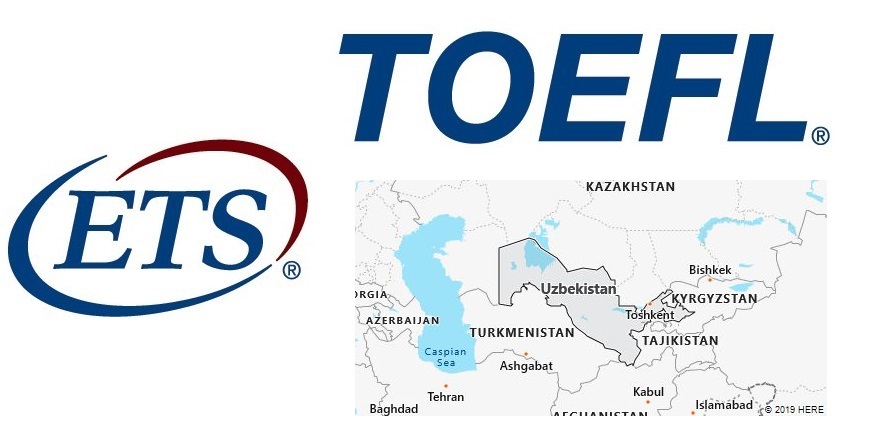The TOEFL iBT test is offered in this location.
The list below shows testing regions, fees and dates as of February 15, 2019, but availability may change when you register. Fees are shown in US$ and are subject to change without notice.
| Region | Testing Format | Fee | Test Dates |
|---|---|---|---|
| Tashkent | TOEFL iBT | $180 $180 $180 $180 $180 $180 $180 $180 $180 $180 $180 $180 $180 $180 $180 $180 |
Sat., Feb 16, 2019 Sat., Mar 09, 2019 Sat., Mar 16, 2019 Sat., Mar 30, 2019 Sat., Apr 06, 2019 Sat., Apr 13, 2019 Sat., May 11, 2019 Sat., May 18, 2019 Sun., May 19, 2019 Sat., Jun 01, 2019 Sat., Jun 15, 2019 Sat., Jun 29, 2019 Sat., Jul 06, 2019 Sat., Jul 13, 2019 Sat., Jul 20, 2019 Sun., Jul 28, 2019 |
Uzbekistan Overview
Uzbekistan is a state in central Central Asia with the capital Tashkent. The country consists mainly of flat desert landscapes. In the middle of Uzbekistan lies the sandy desert of Kyzylkum, which takes up around 40% of the total area of the country. In the northwest, Uzbekistan has a share in the drying Aral Sea. In the east, high mountain ranges enclose the fertile Fergana Basin. There is a dry continental climate with long hot summers and short cold winters. The people live mainly in the oases of the foothills and in the cities along the old Silk Road. The official language is Uzbek and in the Autonomous Republic of Karakalpakistan Karakalpakisch. Russian is the lingua franca of education and business. The predominant religion is the Sunni Islam.
Changing peoples such as the Persians, Seleucids, Arabs, Turks and Mongols have shaped the area of today’s Uzbekistan over the centuries. In the 15th century, the Turkic Uzbeks immigrated from Western Siberia and mixed with the local population. Russians conquered the region in the 19th century. In 1924 the Uzbek Soviet Republic was established within the Soviet Union. In 1991 the country declared its independence. The first president was Islam Karimow (* 1938, † 2016). He greatly expanded his power and prevented the development of democratic structures. Uzbekistan has close ties with Russia and is a member of the CIS. Raw materials such as natural gas, gold, uranium and copper are mined and processed in Uzbekistan. The industrial, service and agricultural sectors make a balanced contribution to national value creation. The monoculture cultivation of cotton has caused great environmental damage.
Country facts
- Official name: Republic of Uzbekistan
- License plate: UZ
- ISO-3166: UZ, UZB (860)
- Internet domain:.uz
- Currency: 1 Uzbekistan Sum (US) = 100 Tijin
- Area: 447 400 km²
- Population (2018): 33 million
- Capital: Tashkent
- Official language (s): Uzbek
- Form of government: Presidential Republic
- Administrative division: 12 regions (Viloyatlar), capital region, 1 autonomous republic
- Head of State: President Shawkat Mirsiyoyev
- Head of Government: Abdulla Aripov
- Religion (s): 88% Muslims (Sunnis), 9% Christians (Orthodox), others
- Time zone: Central European Time +4 hours
- National holiday: September 1st
Location and infrastructure
- Location (geographical): Central Asia
- Position (coordinates): between 37 ° 10 ‘and 45 ° 39’ north latitude and 55 ° 50 ‘and 73 ° 09’ east longitude
- Climate: Continental desert climate
- Highest mountain: Hazrat Sulton (4643 m)
- Road network (2000): 75 511 km (paved), 10 985 km (unpaved)
- Railway network (2018): 4 642 km
Population
- Annual population growth (2018): 0.9%
- Birth rate (2018): 16.6 per 1000 residents.
- Death rate (2018): 5.4 per 1000 residents.
- Average age (2018): 29.1 years
- Average life expectancy (2018): 74.3 years (women 77.5; men 71.2)
- Age structure (2018): 23.6% younger than 15 years, 5.4% older than 65 years
- Literacy rate (15-year-olds and older) (2016): 100%
- Mobile phone contracts (pre-paid and post-paid) (2017): 76 per 100 residents
- Internet users (2017): 52 per 100 residents
Economy
- GDP per capita (2018): US $ 1,263
- Total GDP (2018): US $ 41 billion
- GNI per capita (2018): US $ 2,020
- Education expenditure (2017): 6.4% of GDP
- Military expenditure (2018): 4% of GDP
- Unemployment rate (2017): 7.2%
Economy
Uzbekistan has experienced steady economic growth since the 2000s, and the economic and investment climate has improved when President S. Mirsiyoyev took office. Since the beginning of 2017, the government has adopted many economic reforms to lure foreign company founders into the country. Numerous company regulations and trade barriers were lifted in order to limit the excessive bureaucracy and corruption.
The country is rich in natural resources, especially natural gas, oil, coal, copper and gold. Mining and industry generate a quarter of the national value added (GDP). Next to the food factories, the chemical industry, which mainly produces fertilizers, is the most important branch. In the textile industry, cotton and the products of sheep and silkworm breeding are processed. Carpet manufacture looks back on a long tradition. In agriculture, cotton growing on irrigated fields plays an important role. Increasingly, however, cotton fields are being given up and fruit and vegetables are being grown instead. This is more economical because it means you no longer have to import so much food. The agricultural sector is an important branch of the economy with 30% of GDP and around 22% of employees. For comparison: In Germany, the agricultural sector generates 0.8% of GDP with 1.3% of employees. The most important branch of the economy with 34% of GDP and 40% of employees is the service sector; in Germany, 71.5% of employees work in this sector.
Corruption and state-prescribed price and wage controls have resulted in the income situation of large sections of the population having barely improved in recent years. Many Uzbeks have started work abroad, especially in Russia and Kazakhstan.

